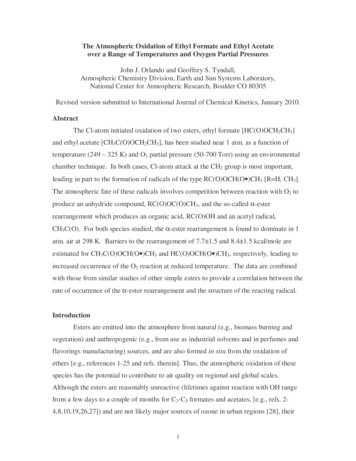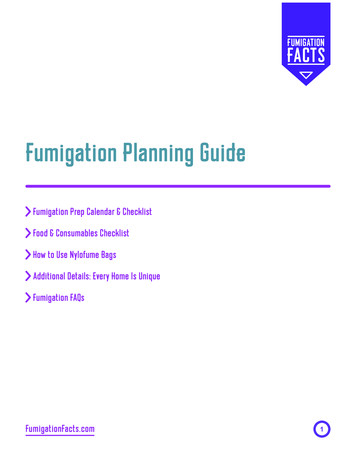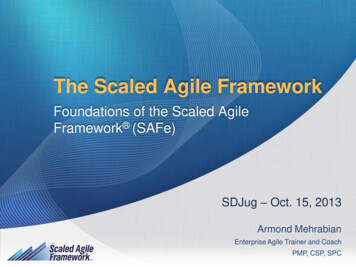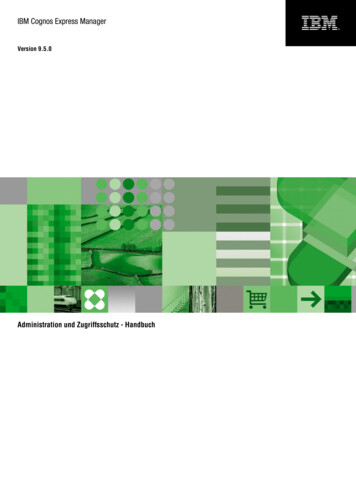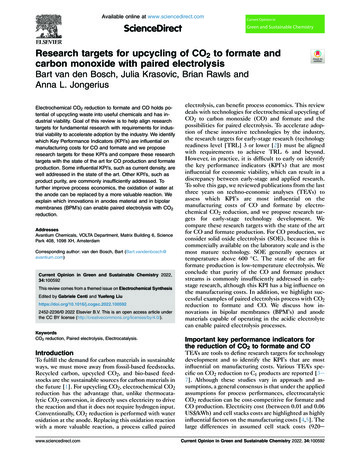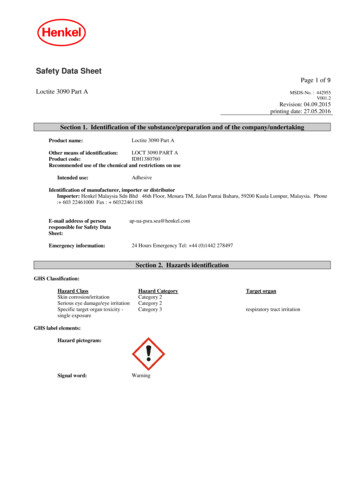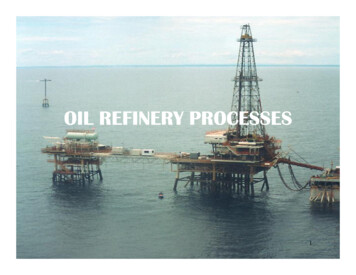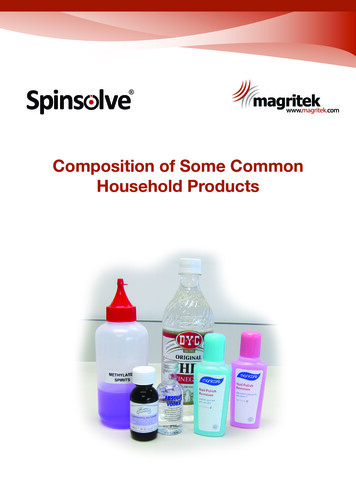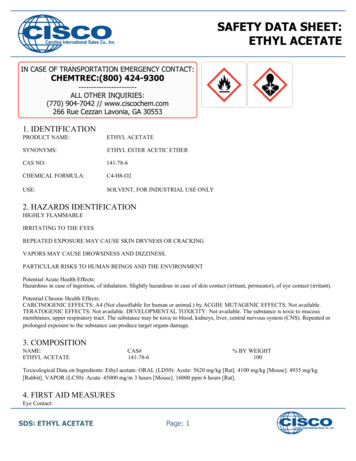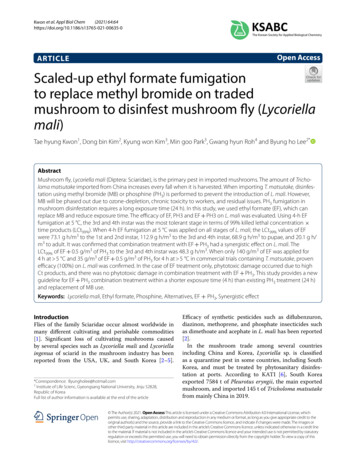
Transcription
(2021) 64:64Kwon et al. Appl Biol Chemhttps://doi.org/10.1186/s13765-021-00635-0Open AccessARTICLEScaled‑up ethyl formate fumigationto replace methyl bromide on tradedmushroom to disinfest mushroom fly (Lycoriellamali)Tae hyung Kwon1, Dong bin Kim2, Kyung won Kim3, Min goo Park3, Gwang hyun Roh4 and Byung ho Lee2*AbstractMushroom fly, Lycoriella mali (Diptera: Sciaridae), is the primary pest in imported mushrooms. The amount of Tricholoma matsutake imported from China increases every fall when it is harvested. When importing T. matsutake, disinfestation using methyl bromide (MB) or phosphine (PH3) is performed to prevent the introduction of L. mali. However,MB will be phased out due to ozone-depletion, chronic toxicity to workers, and residual issues. P H3 fumigation inmushroom disinfestation requires a long exposure time (24 h). In this study, we used ethyl formate (EF), which canreplace MB and reduce exposure time. The efficacy of EF, PH3 and EF PH3 on L. mali was evaluated. Using 4-h EFfumigation at 5 C, the 3rd and 4th instar was the most tolerant stage in terms of 99% killed lethal concentration time products (LCt99%). When 4-h EF fumigation at 5 C was applied on all stages of L. mali, the LCt99% values of EFwere 73.1 g h/m3 to the 1st and 2nd instar, 112.9 g h/m3 to the 3rd and 4th instar, 68.9 g h/m3 to pupae, and 20.1 g h/m3 to adult. It was confirmed that combination treatment with EF PH3 had a synergistic effect on L. mali. The LCt99% of EF 0.5 g/m3 of PH3 to the 3rd and 4th instar was 48.3 g h/m3. When only 140 g/m3 of EF was applied for4 h at 5 C and 35 g/m3 of EF 0.5 g/m3 of PH3 for 4 h at 5 C in commercial trials containing T. matsutake, provenefficacy (100%) on L. mali was confirmed. In the case of EF treatment only, phytotoxic damage occurred due to highCt products, and there was no phytotoxic damage in combination treatment with EF PH3. This study provides a newguideline for EF PH3 combination treatment within a shorter exposure time (4 h) than existing P H3 treatment (24 h)and replacement of MB use.Keywords: Lycoriella mali, Ethyl formate, Phosphine, Alternatives, EF PH3, Synergistic effectIntroductionFlies of the family Sciaridae occur almost worldwide inmany different cultivating and perishable commodities[1]. Significant loss of cultivating mushrooms causedby several species such as Lycoriella mali and Lycoriellaingenua of sciarid in the mushroom industry has beenreported from the USA, UK, and South Korea [2–5].*Correspondence: Byungholee@hotmail.com2Institute of Life Scienc, Gyeongsang National University, Jinju 52828,Republic of KoreaFull list of author information is available at the end of the articleEfficacy of synthetic pesticides such as diflubenzuron,diazinon, methoprene, and phosphate insecticides suchas dimethoate and acephate in L. mali has been reported[2].In the mushroom trade among several countriesincluding China and Korea, Lycoriella sp. is classifiedas a quarantine pest in some countries, including SouthKorea, and must be treated by phytosanitary disinfestation at ports. According to KATI [6], South Koreaexported 7584 t of Pleurotus eryngii, the main exportedmushroom, and imported 145 t of Tricholoma matsutakefrom mainly China in 2019. The Author(s) 2021. Open Access This article is licensed under a Creative Commons Attribution 4.0 International License, whichpermits use, sharing, adaptation, distribution and reproduction in any medium or format, as long as you give appropriate credit to theoriginal author(s) and the source, provide a link to the Creative Commons licence, and indicate if changes were made. The images orother third party material in this article are included in the article’s Creative Commons licence, unless indicated otherwise in a credit lineto the material. If material is not included in the article’s Creative Commons licence and your intended use is not permitted by statutoryregulation or exceeds the permitted use, you will need to obtain permission directly from the copyright holder. To view a copy of thislicence, visit http:// creat iveco mmons. org/ licen ses/ by/4. 0/.
Kwon et al. Appl Biol Chem(2021) 64:64According to the phytosanitary guideline in Korea,imported mushrooms infested with L. mali must bechemically treated with methyl bromide (MB). In thecase of exported mushrooms, pest free inspection wasthe last option to avoid rejecting them in countries wherethey are imported with the option not to treat with MBbecause it caused loss of quality. As well as phytotoxicdamage to mushrooms treated with MB, its use has beenphasing out because of ozone depletion properties andchronic toxicity to human in Korea [7]. MB fumigation on food commodities could be more difficult in thefuture because there is a need to update residual bromide ion and MB itself post all type of food commodities associated with the new Positive List System (PLS)in Korea [8]. In Korea, MB fumigation on treaded mushrooms will be discontinued after 2022 (Personal communication with MG Park), because there is currently noconsumer safety data supported in Korea. In the case of PH3 fumigation, as current alternative options, commercial adaptation might be difficult because a long exposure time is required in grains ( 5 days) and mushrooms( 1 days), which could shorten the shelf life of mushrooms [9].Ethyl formate (EF), an alternative to MB, is knownto be safer than other fumigants in the workplace andthere is residual free regulation in many countriesbecause it is globally classified as a food additive. Inpractice, EF fumigation has been used in imported commodities such as fruits, vegetables, nursery plants, etc.[10, 11]. A new concept of EF application technologywith N2 (Non-CO2) was developed and used commercially in Korea [9].Although EF was effective fumigant, it has high sorption [12] to commodities like perishable fruits and vegetables and more less vaporization at low temperature[13]. PH3 was good at permeability to commodites liketimber [14]. Thus the new concept of fumigation hasbeen studied that combined EF and PH3, which was moreeffective to insect pests and less phytotoxic damage tocommodities [15, 16].No study evaluating the efficacy of EF on L. mali hasbeen reported. Herein, we suggest new disinfestationguidelines for disinfestation of L. mali using EF andEF PH3, which are a replacement for MB.We evaluated (1) Efficacy of EF for 4 h-fumigation on L.mali in lab studies, (2) sorption studies on several typesof mushroom and gas penetration under imported conditions, (3) Synergestic effect of EF and P H3 to L. maliand Phytotoxic damage to mushroom with EF PH3fumigation. (4) application of liquid EF with N2 application on a commercial scale for confirmation on importedmushrooms.Page 2 of 11Materials and methodsInsects and chemicalsLycoriella mali was collected from a mushroom farmin Yeongcheon, Gyeongbuk, South Korea during 2020.L. mali were transferred and reared in an insect rearing room at Gyeongsang National University. L. maliwas maintained in the insect rearing room at 24 C and60–70% relative humidity (RH) with a 16:8 [L:D] h.Pleurotus eryngii was provided as a food source. Femaleadults of L. mali lay eggs on water agar (2%) in the insectbreeding dish (100 mm 40 mm). Larvae pupated within5–6 days, and adults emerged within 25 days; 1st, 2nd,3rd and 4th instar larvae, pupae, and adults were usedin this study. EF (Fumate , 99% purity; Hoengseong,Korea) was supplied by Safefume Co. Ltd in Korea. Phosphine was purchased as ECO2Fume (2% PH3 98% CO2)from Cytec (Sydney, Australia).Egg hatching test at low temperatureEgg hatching studies of L. mali were performed at 5 0.5 Cin an incubator. The eggs were collected form rearing cageswith 200 mated females on the Pleurotus eryngii over 1 dayand treated immediately. Before fumigation to eggs, 2%agar medium was laid on the bottom of the breeding dish(50 mm 15 mm) to maintain moisture and cut pine of P.eryngii was placed on the agar medium. Then 20 eggs of L.mali were transferred to each cut pine of P. eryngii. Becausethe egg color is transparent, the cut pine of P. eryngii wasdyed using natural pigments to make observation of theeggs easier. Following placcement in a 5 C incubator, theegg hatching rate was observed for 5 to 14 days. After 72 hof treatment, eggs were checked hatching rate. Treatmentwas replicated three times, and the control was replicated10 times at room temperature (24 1 C).Efficacy to developmetal stages of L. mali with EFin a laboratory experimentEfficacy of EF was evaluated for three different developmental stages (adult, larvae and pupae) of L mali. Inthe case of EF mixed with PH3 studies, the 3rd and 4thinstars of L mali, which is the most tolerant stage to EF,was evaluated. Adults of L. mali were transferred from abreeding dish (50 mm 15 mm) using collecting equipment (Fulton, MX-991/U, Georgia) within three days ofdeveloping an adult. Adults of L. mali were fumigatedat 5 C for 4 h with 1.0–9.0 g/m3 of EF. The 1st and 2ndinstar and the 3rd and 4th instar were classified andtested. From 1 to 7 days after hatching, the 1st and 2ndinstar and 7 to 14 days were classified into the 3rd and4th instar. The pupae were used within two days after
Kwon et al. Appl Biol Chem(2021) 64:64pupation. Larvae and pupae stages of L. mali were transferred from water agar (2%) to a breeding dish (50 mm 15 mm). The 1st and 2nd instar of L. mali were fumigated at 5 C for 4 h with 1.0–30.0 g/m3 of EF. The 3rd and4th instar were fumigated at 5 C for 4 h with 1.0–45.0 g/m3 of EF. The pupae were fumigated at 5 C for 4 h with1.0–40.0 g/m3 of EF.The concentration of EF was measured using an Agilent portable GC 17A (Shimadzu, Kyoto, Japan) equippedwith a flame ionization detector (FID) after separation ona DB5-MS Column (30 m 0.25 mm i.d., 0.25 µm filmthickness; J&W Scientific, Folsom CA). The oven temperature was 100 C The injector and detector temperatures were 250 and 280 C, respectively. Helium was usedas a carrier gas at the flow rate of 1.5 mL/min. HeadspaceEF was calculated by the peak area against external EFstandards.After completion of 4 h fumigation, treated L. mali wastransferred to an insect rearing room at 24 C and 60–70%relative humidity (RH) with a 16:8 [L:D] h. The mortalityof the treated L. mali larvae and adults were determinedby visual inspection of movement using a microscope 1day after fumigation. The mortality of the treated L. malipupae was determined by checking the number of adultsfor 5 days after fumigation. Usually, the rate of pupae toadults in the control group was 50% level. All treatmentsand controls were replicated three times.The temperature was recorded using data loggers(Thermo Recorder TR-72Ui, T&D Corp., Japan). In thisstudy, a 6.8 L desiccator was used in the experiment as afumigation chamber. The desiccators were sealed with aglass stopper equipped with a septum (Alltech AssociatesAustralia, Cat. No. 15419). The exact volume of desiccators was measured using weigh of water. The desiccatorswere tightly sealed with high vacuum grease (Dow Corning, USA). A filter paper (Whatman No. 1) was insertedinto the glass stopper to make clear evaporation in thedesiccator for the injected EF. A magnetic bar to stir thefumigant was located at the bottom of the desiccator. Thedose of fumigant and Ct products was calculated usingthe method reported by Ren et al. [14].Efficacy to 3rd and 4th larvae of L. mali with EF combinedwith PH3 in a laboratory experimentFor EF PH3 efficacy studies, the 3rd and 4th instars of Lmali were trasnffered on agar petri dish in desiccator (6.8L). The larvae in the desiccators were fumigated at 5 C for4 h with 4.0–28.0 g/m3 of EF mixed with 0.5 and 1.0 g/m3 of P H3. Analysis of EF concentration was as shownabove, the concentration of P H3 was measured using Agilent 7890A equipped with a flame photometric detectorPage 3 of 11(FPD) and HP-PLOT/Q (30 m 530 µm 40 µm, Agilent, Santa Clara, CA) operating in split mode (10:1). Thetemperature of the injector and the oven was 200 . Thetemperature of the detector was 250 C. The injection volumes and flow rate of EF and P H3 were 60 µl and 20 and1.5 and 5 ml/min, respectively.Determination of the synergistic effect of ethyl formatemixed with phosphine against the 3rd and 4th larvae of L.maliAfter efficacy to EF alone fumigation and EF combinedwith PH3 fumigation, we evaluated synergistic effect.A synergistic effect was measured by synergistic ratios(SRs). Synergistic ratios are defined by Hewlett andPlackett [17] and based on equation. 1.SR L(Ct) of ethyl formate onlyL(Ct) of ethyl formate phosphine(1)*SR 1 describes additive action,SR 1 describes antagonism,SR 1 describes synergism.Sorption test of T. mastutake for 4 h EF fumigationin a laboratory experimentEvaluation of sorption of EF on T. matsutake was performed in a 6.8 L desiccator under lab condition. Each T.matsutake was filled at a 0.5, 1, and 1.5% filling ratio (w/v)for the sorption test; 140 g/m3 of EF was applied usinga syringe for 4 h at 5 C. Gas sampling was performed attime intervals (10 min, 1, 2, and 4 h) and measurementswere performed using an Agilent portable GC 17A (Shimadzu, Kyoto, Japan) equipped with a flame ionizationdetector (FID) after separation on a DB5-MS Column(30 m 0.25 mm i.d., 0.25 µm film thickness; J&W Scientific, Folsom, CA).Gas penetration test of EF on packed mushroomswith logistic consideration (Styrofoam box)In the case of import and export Tricholoma matsutake,a styrofoam box with an ice pack was used as packingmaterials. Evaluation of gas penetration of EF on packedmushrooms (Tricholoma matsutake) was performed ina 0.275 m3 fumigation chamber at 5 C. Each mushroomwas filled at a 1.0% filling ratio (w/v) for the gas penetration test; 35, 70 and 140 g/m3 of EF was applied using aspecial vaporizer (supplied by Safefume Co.) for 4 h at5 C. The two conditions (inside, outside of the Styrofoambox) of EF concentration were analyzed. Gas samplingwas performed at time intervals and measurements wereperformed using an Agilent portable GC 17A.
Kwon et al. Appl Biol Chem(2021) 64:64Commercial scaled‑up fumigationEF alone fumigation on Tricholoma matsutakeScale-up fumigation was performed using a 25 m3Tarp-fumigation chamber in the Incheon airport warehouse in South Korea. Tricholoma matsutake wereplaced in a styrofoam box (1.7% f.r.) and the coverof the box was opened, which is based on commercial use. Then, 140 g/m3 of EF was applied for 4 h at5 C. Liquid EF was vaporized with SFM-I (supplied bySafefume Co.) with N2 as the carrier gas and a fan wasplaced at the bottom of the Tarp-chamber for efficientgas circulation. The concentrations of the inside andoutside of the styrofoam box were analyzed. Three ofthe insect breeding dishes containing 300 larvae of L.mali (total 1079) were then located in the styrofoambox. Gas sampling was collected at time intervals (0,1, 2, and 4 h) and EF concentration inside and outsideof the styrofoam box was measured using GC-FID.Because measurement with GC-FID directly at thefield is impossible, the concentration was checked inadvance at the field using a gas analyzer (IBRID MX6;Industrial Scientific, Pittsburgh, PA, USA). A previousstudy found no sigfinicant difference in the measuredconcentration of IBRID and GC-FID. Fumigated larvaeof L. mali were transferred to an insect rearing room.The mortality of larvae was determined 1-d after fumigation. All treatments and controls were replicatedthree times.EF fumigation mixed with PH3 on Tricholoma matsutakeScale-up fumigation was performed using a 5 m3 fumigation chamber in the same APQA site in South Korea.Tricholoma matsutake were placed in a styrofoam box(0.5% f.r.) and the cover of the box was opened, whichis based on commercial use. Then, 35 g/m3 of EF mixedwith 0.5 g/m3 of P H3 was applied for 4 h at 5 C. Liquid EF was vaporized using a vaporizer (supplied bySafefume Co.) with N 2 as the carrier gas and a mini fanwas placed at the bottom of the chamber for efficientgas circulation. The concentration of PH3 was achievedby injecting 125 ml of 2% P H3 into a 5 m3 fumigationchamber. The concentrations of the inside and outsideof the styrofoam box were analyzed. Three insect breeding dishes containing 300 larvae of L. mali (total 1,097)were then located in the styrofoam box. Gas samplingwas collected at time intervals (0, 1, 2, and 4 h) and EFand PH3 concentrations inside and outside of the styrofoam box were easured using GC-FID and GC-FPD.Fumigated larvae of L. mali were transferred to aninsect rearing room. The mortality of larvae was determined 1-d after fumigation. All treatments and controlswere replicated three times.Page 4 of 11Phytotoxic assessmentThe phytotoxic damage of EF on mushrooms (Pleurotus eryngii, Tricholoma matsutake,) was evaluated inscaled-up studies (5 m3 fumigation chamber). Two typesof mushrooms were filled at a 1.5% filling ratio; 140 g/m3 of EF for Pleurotus eryngii and 140 g/m3 of EF and35 g/m3 of EF 0.5 g/m3 PH3 for Tricholoma matsutakewere applied using a special vaporizer (supplied by Safefume Co.) for 4 h at 5 C. After completion of fumigation,mushrooms were transferred to storage at 5 0.8 C. Thedeterioration degrees were classified according to symptoms of the water condensation surface of the cap andchanging a soft cap, grill, stem parts (0: Non, 1: watercondensation, 2: water condensation following changinga soft cap and grill parts 3: water condensation following changing a soft cap, grill and then stem part). A colorchange (hue value) using a color meter (TES 135A, Taiwan), weght loss (%, weight differences before and aftertreatment) and market value based on the hardness ofhead parts (the harder the best, the softer the worst) wereevaluated 3-d after fumigation.Statistical analysisAnalysis of the toxicological dose response to EF by L.mali was based on a Probit analysis (Finney, 1971). Aspart of the analysis, the slopes of the Probit transformations were determined as well as Chi-square tests ofdata homogeneity for different treatments. The indicesof toxicity measurement derived from this analysis wereL(Ct)50% median lethal concentration that causes 50%response (mortality) and L(Ct)99% lethal concentrationthat causes 99% response (mortality) of exposed L. malidetermined from a range of at least 10 different Ct products to ensure that the observed data covered mortalityfrom 0 to 100% and adequately covered the intermediaterange. For analysis of the hatchability of eggs on two temperatures and phytotoxic damage assessment of EF fumigation, on mushrooms, a T-test procedure was used tocompare the two sample means. The EF alone fumigationand EF combined with PH3 fumigation against phytotoxicity of mushrooms were compared using Tukey’s test inscaled-up trials. All statistical analyses were performedusing SAS (ver. 9.4; SAS Institute Inc.) [18].Results and discussionEgg hatchability test at low temperatureThis study was conducted to investigate eggs hatching inlow temperature conditioned mushrooms. According toprevious ecological studies on L. mali, the average lengthof a generation from egg to adult was 28 d at 21 C [19]; it
Kwon et al. Appl Biol Chem(2021) 64:64Page 5 of 11Table 1 Egg hatchability of Lycoriella mali under two conditions (5 0.5 , 24 1.0 )Day after oviposition567891011121314*Temperature (mean SE, )5 0.524 1.05 0.524 1.05 0.524 1.05 0.55 0.55 0.55 0.55 0.55 0.55 0.5No. of testedNo. of an SE, %) 0.00010.0 0.088.3 1.7* 0.00010.0 0.0100.0 0.0 0 0.0100.0 0.00.0 0.00.0 0.00.0 0.00.0 0.00.0 0.00.0 0.00.0 0.0All the unhatched eggs were emergedll at 6-d after oviposition- impossible to checkTable 2 LCt (Lethal Concentration time) value of EF fumigation for 4 h expoure on Lycoriella mali at 5 0.5 StageL(Ct)50% (95% CL)L(Ct)99% (95% CL)1st, 2nd instar43.6 (37.1–53.3)73.1 (68.4–100.2)3rd, 4th instar27.84 (22.53–33.01)112.9 (90.70–152.25)Pupae36.8 (28.9–46.1)68.9 (57.6–97.1)Adults7.8 (5.8–13.9)20.1 (16.6–26.2)took five days from eggs to hatching. The egg hatchability under normal temperature condition (24 1 C) were88.3 1.7% and 100.0 0.0% at the day of the 5th and 6thday after oviposition (Table 1). However, we confirmedthat the eggs under low temperature (5.0 0.5 C) did nothatch at all. Based on logistic distribution of importedT. matsutake from China, it takes at least five days fromharvest to consumers, all logistics is under 5 C, meaning that survival of the egg might be diffidult under coldtemperature conditions if found in imported mushrooms.Slope SEdfχ23.1 0.34.3 0.32128.93.2 0.32848.471540.22.0 0.41332.1Table 3 Efficacy of PH3, EF and EF PH3 fumigation for 4 hexpoure on Lycoriella mali at 5 0.5 Fumigant doseCt products (g h/m3)Mortality SE (%)Control0.0PH3 0.5 g/m31.8PH3 1.0 g/m33.5EF 6.0 g/m314.8EF 10.0 g/m326.4EF 18.0 g/m344.9Efficacy to developmetal stages of L. mali with EFin a laboratory experimentEF 26.0 g/m365.5The efficacy of 4 h EF fumigation (practical exposurecondtion using EF fumigations in Korea) on larvae,pupae, and adults stages of L. mali at 5 is shown inTable 2. For the 1st and 2nd of L. mali larvae, the L(Ct)50%and L(Ct)99% values of EF were 43.6, 73.1 g h/m3. For the3rd and 4th of L. mali larvae, the L(Ct)50% and L(Ct)99%values of EF were 25.0 and 112.9 g h/m3. The L(Ct)50%and L(Ct)99% values of EF on L. mali pupae were 36.8 and68.9 g h/m3 andadults were 7.8 and 20.1 g h/m3 at 5 C(Table 2), respectively. Thus, the order of susceptivelyPH3 0.5 g/m3 EF 10.0 g/m31.8 26.6PH3 0.5 g/m3 EF 18.0 g/m31.8 45.7100.0 0.0PH3 0.5 g/m3 EF 26.0 g/m31.8 65.7100.0 0.0PH3 1.0 g/m3 EF 18.0 g/m33.6 47.0100.0 0.0PH3 1.0 g/m3 EF 26.0 g/m33.5 65.6100.0 0.0PH3 0.5 g/m3 EF 6.0 g/m3 1.8 15.20.0 0.00.0 0.00.0 0.020.0 2.946.7 1.786.7 1.795.0 0.041.7 1.740.0 2.9
Kwon et al. Appl Biol Chem(2021) 64:64Page 6 of 11Table 4 LCt (Lethal concentration x time) value of EF mixed with 0.5 g/m3 PH3 for 4 h exposure on Lycoriella maliTemp ( )StageL(Ct)50% (95% CL)L(Ct)99% (95% CL)Slope SEdfχ253rd, 4th instar34.4 (33.3–35.7)48.3 (44.9–53.9)15.8 1.81677.59Table 5 Syngeristic efficacy of EF mixed with 0.5 g/m3 PH3 on3rd–4th larvae stage of Lycoriella maliTemp ( )StageaSynergistic ratiosL(Ct)50%b53rd–4th larvae0.812.34Synergistic ratiosL(Ct)99%aSynergistic ratios (SRs): L(Ct)50% of ethyl formate only/ L(Ct)50% of ethylformate 0.5 g/m3 phosphinebSynergistic ratios (SRs): L(Ct)99% of ethyl formate only/ L(Ct)99% of ethylformate 0.5 g/m3 phosphineof L. mali life stages to EF based on L(Ct)99% values wasadults pupae 1st and 2nd instar 3rd and 4th instarlarvae. Drosophila suzukii (Diptera: Drosophilidae) of theother flies was also most tolerant larval stage except foreggs [20].Efficacy to 3rd and 4th larvae of L. mali with EF combinedwith PH3 in a laboratory experiment3The efficacy of EF 0.5 g/m PH3 fumigation for 4 h onthe 3rd and 4th of L. mali at 5 C is shown in Table 3. Themortality of L. mali was no effect with PH3 of 0.5 and1.0 g/m3 for 4 h fumigation, and was 86.7% with EF of18.0 g/m3 for 4 h fumigation, Otherwise, EF combinedwith PH3 of 0.5 g/m3 fumigation for 4 h was controlled100% against 3rd and 4th instar of L. mali (Table 3). TheL(Ct)50% and L(Ct)99% values of EF 0.5 g/m3 PH3 againstthe 3rd and 4th of L. mali were 34.4 and 48.3 g h/m3 at5 C, respectively (Table 4). According to the results ofa preliminary experiment at 5 C, the 3rd and 4th instarwere the most tolerant stages of L. mali. It was confirmedthat application of EF 0.5 g/m3 PH3 to L. mali had asynergistic effect when treated L(Ct)99% at 5 C (Table 5).The fumigant, PH3 was required more longer exposuretimes to kill insect pests than EF [21] and EF was neededto high concentration to control insect pests at low temperature [22]. But mixed usage of these fumigants wouldbe better to control insect pests than alone [15, 16].Sorption test of T. mastutake for 4 h EF fumigationin a laboratory experimentBased on the efficacy studies resulting in L(Ct)99% values of EF on L. mali larvae, which is the most tolerant toEF fumigation in this study, estimated applicable schedules (140 g/m3 EF for 4 h exposure) were performedon T. matsutake. The losses of EF inside the fumigateddesiccators and their adsorption are shown in Fig. Fumiga on me (h)Fig. 1 Concentration loss of EF fumigation (140 g/m3 at 5 for 4 h) on Tricholoma matsutake34
Kwon et al. Appl Biol Chem(2021) 64:64Page 7 of 11The concentration of EF decreased during 4 h of exposure on mushrooms. Loss rate of EF on T.matsutake wasrelatively low, approximately 30% at f.r. 1.5%. But EF wasrequired high concentration due to their high sorption tocommodities like fruits and vegetable, which can cause tophytoxic damage to commodities [23–25].Gas penetration test of EF on packed mushroomwith styrofoam boxEF Concentra on (g/m 3 )A gas penetration test was performed using a 0.275 m3fumigation chamber with different filling ratios of T.matsutake. As a result of EF gas penetration, therewas a difference between the inside and outside ofthe styrofoam box (Fig. 2). When EF 35, 70, 140 g/m3 was applied, Ct products inside the styrofoam boxwere 60.2 2.4, 95.0 2.9 and 167.1 6.1 g h/m3 atf.r. 1.0%, respectively. However, EF Ct products outside the styrofoam box were 89.4 2.2, 136.3 2.3and 219.7 4.1 g h/m3 at f.r. 1.0%, respectively, shownin Fig. 2. Regarding the initial concentration, the concentration of inside was 15–40% of the concentrationof outside. After 2 h of treatment, the inside and outside concentrations were similar. The calculation of Ctproducts in the lab might be different when appliedin actual scaled-up trials because it is denpendent onsealing conditions, temperature, and condition of commodities (water content, logistic packing, etc.). According to our data when determing EF concentration toachieve target Ct products (112.9 g h/m3, Probit estimation for 99% mortality on L. mali) with 4 h exposure,100 g/m3 of EF might be applicable. However, 100 g/m3 of EF could be obtained with proven efficacy ( 99%)under the worst circumstance of commercials. EF concentration inside the styrofoam box containing T. matsutake was lower than outside. The difference of EFconcentration inside and outside the box might be different depending on fanning conditions (running time,numbers of fans, locations of fan, electrical capacity,etc.) during the EF fumigition. Based on unpubuisheddata, we suggested using a fan for more than 2 h at lowmiddle capactity for even distribution of gas.Commercial sized EF fumigationEF alone fumigation on Tricholoma matsutakeThe scaled-up EF fumigation to confirm disinfestationon L. mali was performed using a 25 m3 Tarp-fumigationchamber filled with T. matsutake (1.7% f.r. w/v). When140 g/m3 was applied for 4 h at 5 C, L. mali achieved100% mortality (total 1079 of fumigated L. mali larvae used). The acculatumed Ct products of EF were159.0 3.1, 147.2 2.8 g h/m3 inside, 195.3 4.3 g h/m3outside the styrofoam box (Fig. 3, Table 6). We confirmedmore than achievable L(Ct)99% values and the loss rates ofEF were approximately 70–80% for 4 h exposure, whichwas similar to previous lab condition studies. When conducting this test, we tried to confirm the mortality for L.mali naturally infested in T. matsutake, however collection of a large amount of T. matsutake was impossibleand the number of infested L. mali per mushroom wastoo small. For a small number of L. mali, 100% mortality10035 g/m3 O70 g/m3 O140 g/m3 O9035 g/m3 I70 g/m3 I140 g/m3 I8070605040302010001234Fumiga on me (h)Fig. 2 Gas concentration, when fumigated with 35, 70, and 140 g/m3 EF for 4 h inside (I) and outside (O) of styrofoam box containing 1.0% f.r. ofTricholoma matsutake (temp. 5.1 0.3 )
Kwon et al. Appl Biol Chem(2021) 64:64Page 8 of 11EF concentra on (g/m 3 )100S. B. OS. B. I#1S. B. I#2806040200012Fumiga on me (h)34Fig. 3 Gas concentration when fumigated with 140 g/m3 EF for 4 h on Tricholoma matsutake (f.r. 1.7%) in scaled-up trials (25 m3 Tarp-fumigationchamber, temp.: 7.3 0.4 ). *Gas concentration inside (S. B. I) and outside (S. B. O) the styrofoam boxTable 6 Scaled-up trials of liquid EF-fumigaion and EF PH3 fumigation on Tricholoma matsutakeType and size of fumigation Appl. Dose (g/m3) Packing and Ct products (g h/m3) Mort. (%) (dead/total) Deterioration Market value2gas sampling degree1Fumigation chamber1(25 m3)–UntreatedEF 140.0S.B.(I#1)S.B.(I#2)S.B.(O)Fumigation chamber2(5 m3)–UntreatedEF 35.0 PH3 0.5S.B.(I#1)S.B.(I#2)S.B.(O)0 (0/159)0aB1 B2 C159.0 3.1–100 (331/331)3bDDD100 (387/387)3bDDD195.3 4.3100 (361/361)3bDDD0 (0/159)0aB1 B2 C50.6 0.6100 (397/397)0aB1 B2 C100 (356/356)0aB1 B2 C66.4 0.1100 (344/344)0aB1 B2 Cp-value 0.0001 0.0001147.2 2.8–50.2 1.1S.B: Styrofoam box, Inside (I), Outside (O)##11. Condition: f.r. 1.7%, 7.33 0.39 2. Condition: f.r. 0.5%, 4.94 0.21 The deterioration degrees. 0: Non, 1: water condensation, 2: water condensation following changing soft a cap and grill parts 3: water condensation followingchanging soft a cap, grill and then stem part2Market value based on commercial grades. A: button, B1: young mushroom, B2: mature mushroom, C: overmature mushroom, D: not for salewas achieved. Regarding weight loss, in assessment of 3 dafter fumigation, T. matsutake was not significantly different (df: 16, p-value: 0.8062) (Fig. 4). Likewise, regarding color change, T. matsutake was not significantlydifferent (df: 16, p-value: 0.8198) (Fig. 5.).EF fumigation mixed with PH3 on Tricholoma matsutakeWe proposed EF PH3 combination fumigation. Itwas performed using a 5 m3 co
ing room at Gyeongsang National University. L. mali was maintained in the insect rearing room at 24 C and 60-70% relative humidity (RH) with a 16:8 [L:D] h. Pleurotus eryngii was provided as a food source. Female adults of L. mali lay eggs on water agar (2%) in the insect breeding dish (100 mm 40 mm). Larvae pupated within
